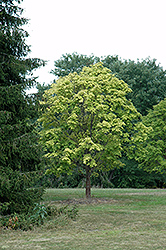Winter Lightning Boxelder
Acer negundo 'Winter Lightning'
Height: 40 feet
Spread: 40 feet
Sunlight:
![]()
![]()
Hardiness Zone: 4
Other Names: Manitoba Maple
Description:
A fast-growing shade tree prized for its dazzling golden-yellow bark, that can really stand out in a winter landscape; yellow fall leaf color as well; makes a great front yard accent tree
Ornamental Features
Winter Lightning Boxelder has attractive green deciduous foliage on a tree with a round habit of growth. The compound leaves are highly ornamental and turn an outstanding yellow in the fall. However, the fruit can be messy in the landscape and may require occasional clean-up. The smooth gold bark and yellow branches are extremely showy and add significant winter interest.
Landscape Attributes
Winter Lightning Boxelder is a multi-stemmed deciduous tree with a more or less rounded form. Its relatively coarse texture can be used to stand it apart from other landscape plants with finer foliage.
This is a high maintenance tree that will require regular care and upkeep, and should only be pruned in summer after the leaves have fully developed, as it may 'bleed' sap if pruned in late winter or early spring. Gardeners should be aware of the following characteristic(s) that may warrant special consideration;
- Messy
- Insects
Winter Lightning Boxelder is recommended for the following landscape applications;
- Accent
- Shade
Planting & Growing
Winter Lightning Boxelder will grow to be about 40 feet tall at maturity, with a spread of 40 feet. It has a high canopy with a typical clearance of 6 feet from the ground, and should not be planted underneath power lines. As it matures, the lower branches of this tree can be strategically removed to create a high enough canopy to support unobstructed human traffic underneath. It grows at a medium rate, and under ideal conditions can be expected to live for 50 years or more.
This tree does best in full sun to partial shade. It is an amazingly adaptable plant, tolerating both dry conditions and even some standing water. It is not particular as to soil type or pH. It is highly tolerant of urban pollution and will even thrive in inner city environments. This is a selection of a native North American species.
